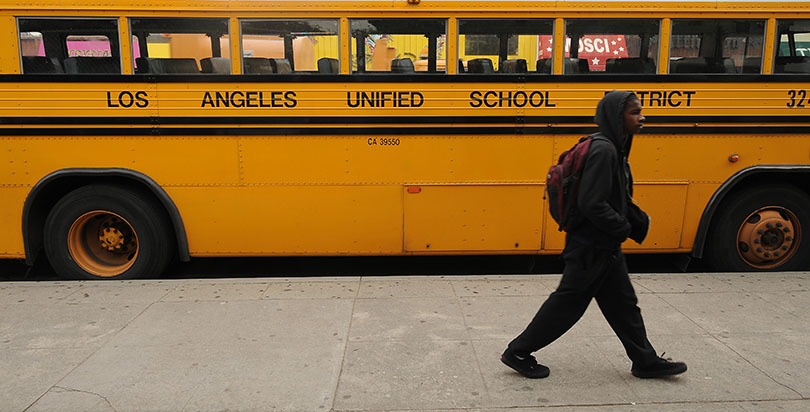LA Union Claims Charters Draining School District, But LAUSD’s Own Numbers Show Charters in the Black

Published in partnership with LA School Report
As Los Angeles Unified School District officials and other analysts continue to pick apart the study released last week (and funded by United Teachers Los Angeles) that claims independent charter schools drain half a billion dollars from LA Unified, the district’s own internal numbers show LA Unified actually makes money from charters.
The first finding of the 42-page union-funded “Cost of Charter Schools” report states that the revenue collected from charter schools does not cover the annual budget of the district’s Charter Schools Division.
But that’s not what the district’s own numbers reveal.
In January when the Charter Schools Division presented its budget, it showed that the district receives half a million dollars more than they need to pay for the division. That report, presented to the Budget, Facilities and Audit Committee by Charters Division Director Jose Cole-Guttierez, showed that the 1 percent oversight fee collected from charter schools brings in $8.89 million while the annual expenses of the division’s 47 employees including their benefits total $8.37 million.
The UTLA report puts the indirect administrative costs of the division at $13.8 million, including the cost of the square footage of space used in the Beaudry headquarters by the staff, janitorial costs and time managing and investigating charters that could be spent on traditional schools. These costs, it states, are not supported by the 1 percent oversight fee collected from charters that is used to fund the district’s charter schools division.
The UTLA study notes the district doesn’t charge the charter schools the full 3 percent it says they could charge for the 56 schools that are located on district sites. That could result in an increase of $2 million for the district, it says. School board member Monica Ratliff pointed out at Tuesday’s board meeting that many of her constituents ask why the full amount is not collected from the charter schools.
The report was immediately criticized by district staff and others, as both inaccurate and an attempt to divert attention from far larger drains on the district’s finances. District officials have been directed to refrain from commenting officially, but they are planning to respond to the report as early as a special school board meeting planned for Tuesday to discuss the budget.
An initial analysis by the Associated Administrators of Los Angeles (AALA), the district’s bargaining unit for middle managers, also noted that the district’s own figures for its charters division contradicted those in the UTLA report. AALA reported that a district official said the number of charters contracting outside the district for special education — and the ensuing financial impact — was vastly misrepresented in the UTLA report. And it questioned whether UTLA was reading the regulations on charter fees correctly and whether the district could charge charters a full 3 percent.
“The report is full of glaring inaccuracies,” the California Charter Schools Association stated in an email. “It mischaracterizes how special education is funded, it ignores millions of dollars that charters pay to the district for facilities, and it guesstimates the staff time of hundreds of district employees, among many other distortions and false conclusions. We’re encouraged that the district will be scrutinizing the report to assess its accuracy. But what’s especially frustrating is that this report totally ignores the most important part of public education: student learning.”
It added, “When it comes to the district’s finances, the elephant in the room is the $13 billion in unfunded post-employment benefit liabilities that places LAUSD in the unenviable position of having to make very hard decisions in the months and years to come. It’s of course no surprise that UTLA’s report made no mention of that issue; they’d rather blame everyone else than offer real solutions for the district’s complex financial problems.”
The UTLA report comes as the district is facing a potential $450 million deficit within three years due to declining enrollment and increasing fixed costs, including pension costs, legal liability and other post-employment benefits.
The report was put together by a Florida-based consulting company, MGT of America, and Susan Zoller, a former teacher and administrator who compiled the report, presented it to the school board on Tuesday.
UTLA spokesperson Anna Bakalis said in a statement, “The data used in the MGT report came directly from the district. We stand behind the figures as given to MGT. We are glad this financial impact report has sparked a dialogue about these issues, and look forward to finding out more ways to address the findings that were laid out in this report.”
Unfunded pensions, which currently top $13 billion and have more than doubled since 2005, make LA Unified the only school district on a list of top 10 government entities across the country that can’t afford their pensions — the top spot going to the city of Detroit.
In January, a company that has performed independent audits of LA Unified for seven years told a school board committee that the district had gone into the red for the first time, with liabilities outstripping assets by $4.2 billion, in large part because of having to report $5.2 billion in retiree pension liabilities.
Another drain on the district is chronic absenteeism which results in an annual loss of $139 million in revenue. Increasing attendance in schools by only one percent — which would make it equal to the average in the state — that could bring in $45 million a year, according to district figures.
And a sweeping report of the Independent Financial Review Panel last fall found that while the district has lost 100,000 students over the past six years, it has actually increased full-time staff. The report, commissioned by former LA Unified Superintendent Ramon Cortines, added, “Given the significantly smaller population of students, these staffing levels need to be reexamined.”
UTLA itself is facing financial trouble. This year’s UTLA operating deficit was estimated at $1.5 million, fueled in large part by increased costs for staff retiree health benefits.
In a financial overview to members last May, the union treasurer, Arlene Inouye, wrote that the union has been operating at a deficit for seven of the last 10 years, partly due to a drop in membership of 10,000 members since 2007. In the last three years alone, she wrote, the union lost “more than $2.5 million.”
To address the losses, UTLA President Alex Caputo-Pearl this year called for and won a $19 per month dues increase.
“Of course UTLA is exaggerating the financial burden of charter schools,” said Jim Blew, director of StudentsFirst California, a nonprofit group working to ensure that every California child has great teachers and great schools. “This is all designed to distract from the real issues: the need for LAUSD to create schools that families would choose voluntarily and to get its finances in order. They simply can’t blame charters for their problems when they offer weak school options and have ballooning staff during shrinking enrollment and out-of-control pension and healthcare costs.”
At another meeting of the Budget, Facilities and Audit Committee Meeting, in March, findings from a 2008 RAND study of the impact of charter schools on the district were cited, which indicated charter growth would not be the district’s greatest financial threat.
It stated, “We don’t believe future enrollment reductions alone would lead to a tipping point; that is, normal reductions in enrollment should be accompanied by comparable reductions in expenditures, including nonschool expenditures. However, large drops in enrollment coupled with sizable increases in the cost of full retiree benefits (which few employers offer) could produce a condition whereby the district loses its ability to compete effectively for human resources with other districts (i.e., unable to offer competitive compensation and/or work environment). This outcome would greatly hamper the district’s ability to provide all its students with a state-of-the-art education.”
Follow all the news from the LAUSD School Board right here.
Get stories like these delivered straight to your inbox. Sign up for The 74 Newsletter

;)
